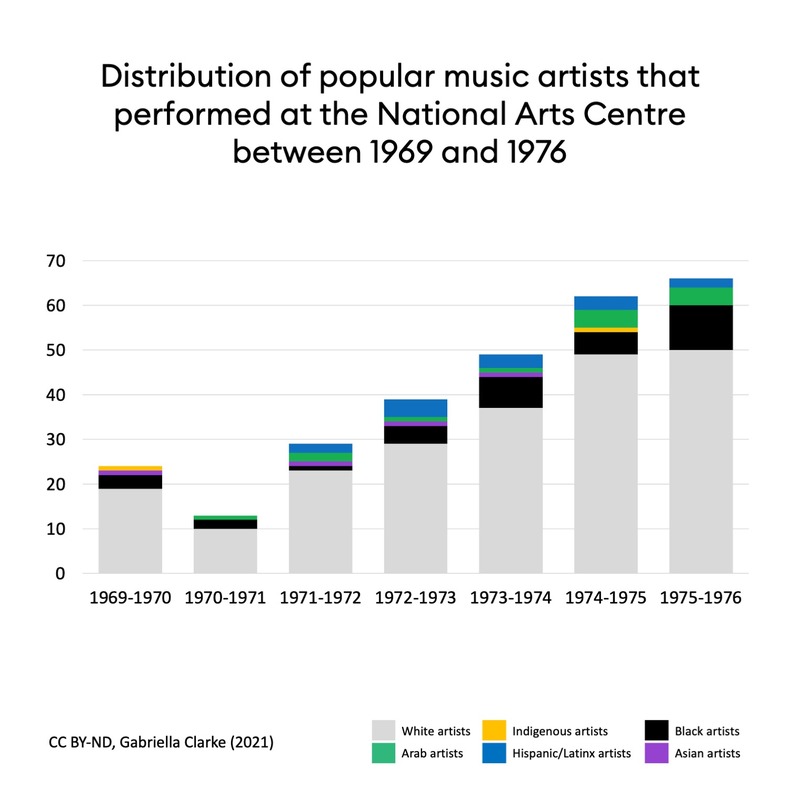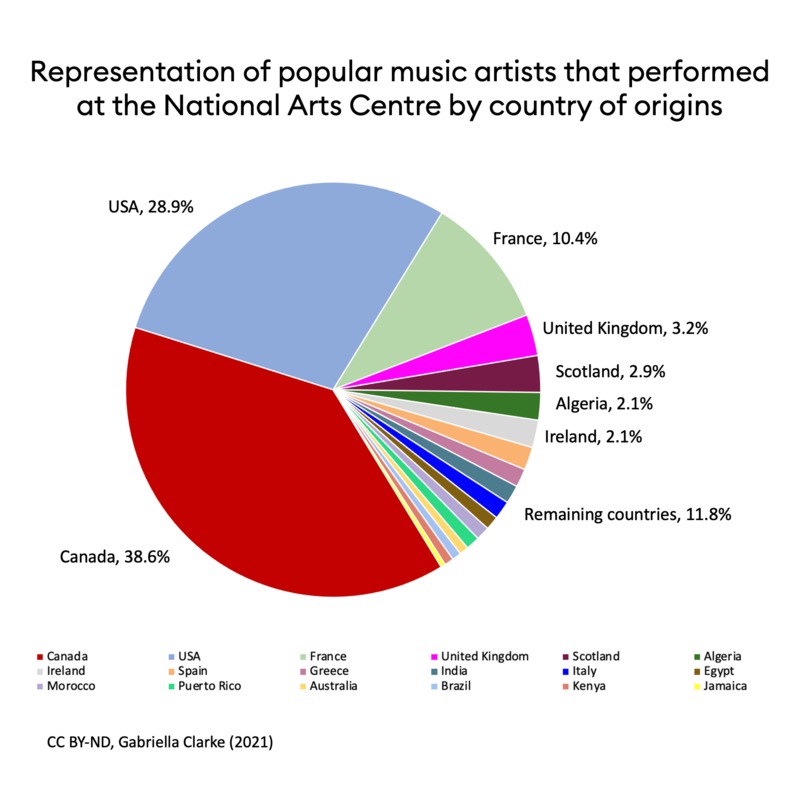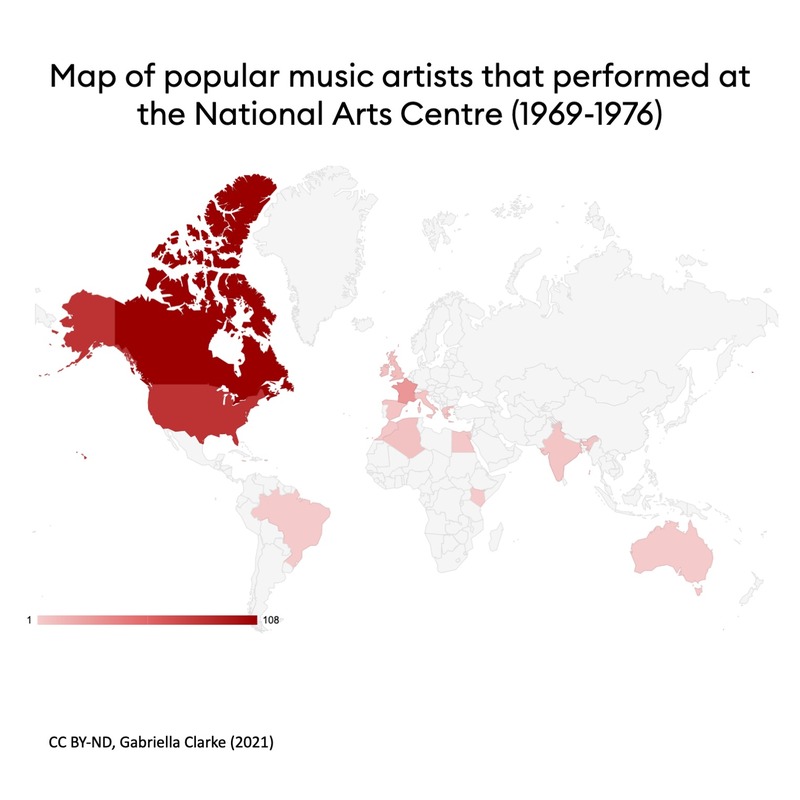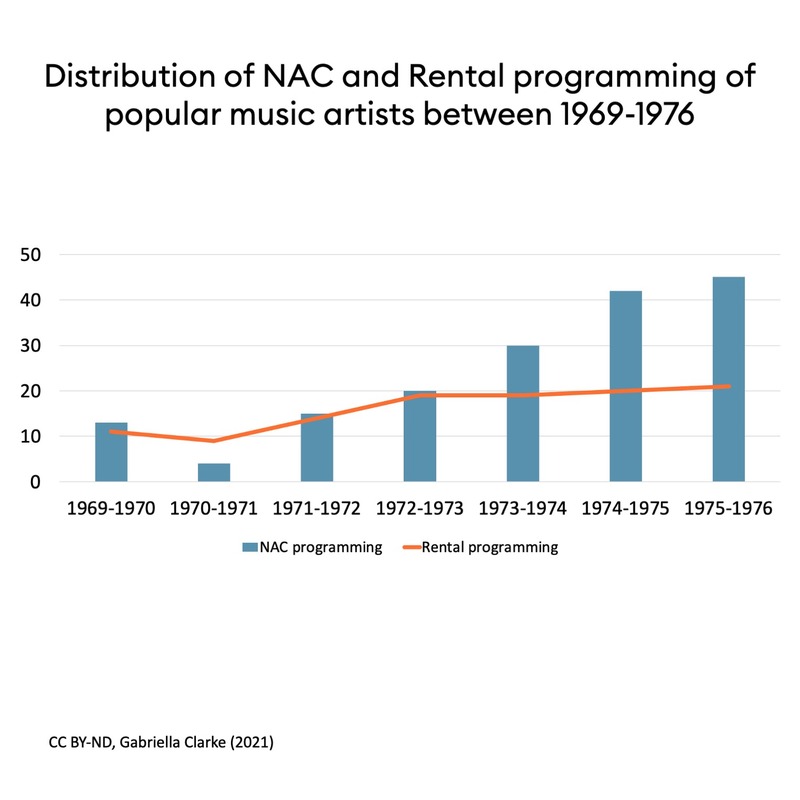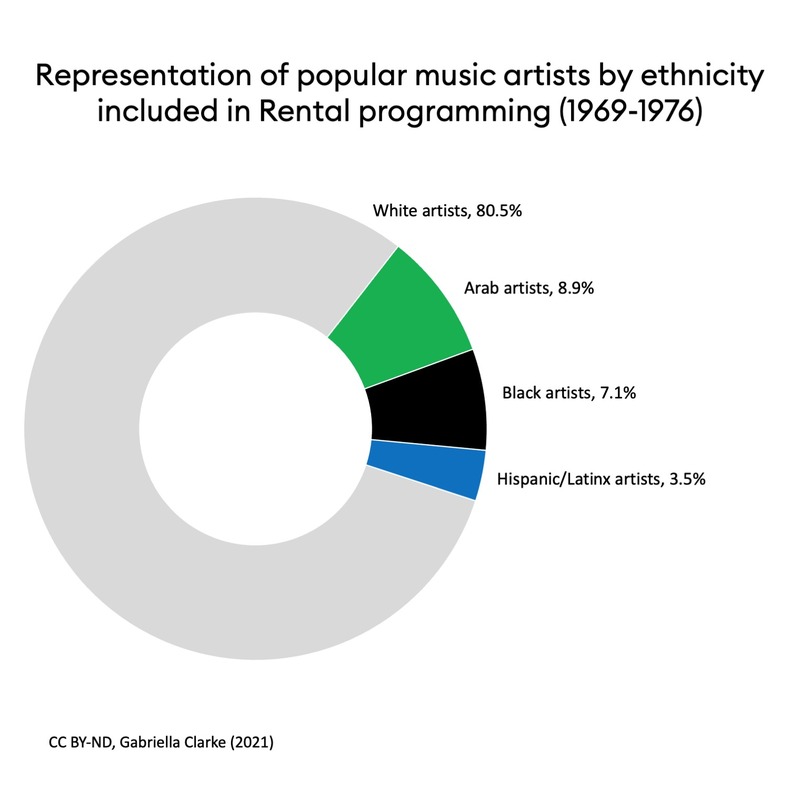Journey Through the Data: Findings
Now Coming to the Stage: The Performers
The NAC’s regard for representing Canada’s through its popular artists can be found in the charts presented here. The results begin by showing the representation of performers by race and ethnicity, then shifts to geographic origins and concludes by reflecting on representation with NAC and rental programming.
Race and ethnicity in NAC programming
It is critical to note from the very outset of this data analysis that the popular music industry was founded on structural racism. As Karl Hagstrom Miller (2010, 1-2) notes in his landmark study Segregating Sound, "[M]usic developed a color line. The blues were African American. Rural white southerners played what came to be called country music. By the 1920s, these depictions were touted in folk song collections as well as the catalogues of ’race’ and ‘hillbilly’ record promoted by the phonograph industry.” While these specific marketing categories are no longer used today (they have been replaced with Country and Soul/R&B), the racial segregation established in the 1920s was institutionalized through the development the recording industry as systems of production, dissemination and recognition developed in the 1950s and have been reinforced through various developments that have followed (Hagstrom Miller 2010; Watson 2021). As such, the period under examination here (1969-1976) is bound to exhibit racial inequity in programming because of the industry under question and the period under examination.
As Figure 1 reveals, 77% of the popular artists that performed were white between 1969 to 1976, with the remaining programming distributed between Black artists (11.3%), Hispanic/Latinx artists (5.0%), Arab artists (4.6%), Asian artists (1.4%) and Indigenous artists (0.7%). Figure 2 then breakdown this data further, showing the distribution (by number of performances) over the course of this seven-year period. What is striking from this graphic is not just the overwhelming whiteness of the performances, but the rate at which white performers increasingly dominate popular music programming on the NAC stages. White artists average 73.8% of the programming over the course of this period – even in years with few popular music performances.
Between 1969 to 1976, there was never a year in which popular artists from all ethnic groups represented performed at the NAC. Over the course of this period, there was a 71% increase in popular music programming, the majority of which went to white artists. Even though there was an increase in representation of Black artists, the results show an increase from 3 performers in the 1969-1970 season to just 7 in the 1975-1976 season. Hispanic and Arab artists were absent from programming in the first years, but are represented in the last few seasons studied here.
It is important to note that the indigenous percentages seen in the graphs can be attributed to one popular artist, Buffy Saint-Marie. In the first seven years of its opening, Buffy Saint-Marie performed twice, once in 1969 and once in 1974. She is the extent of the Indigenous representation of popular artists on the NAC stage.
Gender representation on the NAC's stages
Examining representation by gender is also critical to this discussion. The popular music industry (like Western classical music) was not just founded on structural racism, but it also developed along lines that placed women in a secondary position to male artists. As such, these double forms of oppression are often evident in platforms of representation throughout the industry and are evident in performance lineups like the popular music series at the NAC. Figure 3 graphs the distribution of artists by race and gender, revealing that the majority of the artists on the NAC’s stage (77.7%) were men, while just 16.0% were women and 6.4% were male-female ensembles.
As clearly observed from Figure 3, a racial hierarchy emerges within this lens, revealing that white men (58.5%) and white women (12.1%) are represented in higher percentages than all other artists, and even though Black men are third (9.2%), male artists of other ethnicities are underrepresented, and women of colour are nearly absent from NAC programming.
Geo-origins of artists on NAC's stages
Unsurprisingly, for a performing arts centre built to present Canadian culture, the majority of the NAC’s programmed popular artists were from Canada. Figures 4 and 5 reveal the geographic origins of the artists that graced the NAC’s stage, revealing that Canadians made up 38.6% of the programming. Artists from the USA then came in second (28.9%) with France in third (10.4%). The high representation of the nation’s neighbours to the south (USA) and of France – with whom the nation has a strong heritage connection is not particularly surprising. 22.1% of the programming is distributed (in descending order) betweenthe UK, Scotland, Algeria, Ireland, Spain, Greece, India, Italy, Egypt, Morocco, Puerto Rico, Australia, Brazil, Kenya and Jamaica.
NAC vs. Rental: Diversity differences?
What is perhaps most critical to understand with this data is representation by programming type. Popular music performances were not just part of the NAC’s programming, but the venue was also rented out to touring musicians.
As discussed earlier, there was an increase in popular music programming over the course of this period, with the exception of one year. Figure 6 graphs the distribution of NAC programmed events (in columns) against rental performances (in a line graph). In the 1970-1971 season just 13 popular music events were programmed, 9 of which (69.2%) were rentals. This year is a bit of an outlier in an otherwise upward trajectory of both popular music programming (in general) and NAC’s own events (in particular). While more research into the institutions broader programming of that season would be help, part of this dip in popular music performances can be explained by the large amount of orchestra and film society performances that happened that year.
Drawing together the data on programming type with the identity of performers on NAC stages is important for considering whether or not the performances of visible minorities were part of NAC’s programming or part of the rental programming. Figures 7 and 8 reveal the distribution of popular musicians programmed between 1969 to 1976 represented by ethnicity and separated performance type (NAC or rental).
Figure 7 shows that 74.6% of the popular artists featured in NAC’s programs were white (74.6%), while 14.2% were Black artists, 5.9% were Hispanic artists, 2.4% were Asian artists, and 1.2% were Indigenous artists (again, this was just one artist). Perhaps most surprisingly, not only were rental performances dominated by white artists, but there was a higher percentage of white artists at 80.5% of the programming – the remaining 19.5% were Arab (8.8%), Black (7.1%) or Hispanic (3.5%).
What is critical to recognize in Figure 8, is that though what is represented are programmed popular artists that rented the NAC stage, the organization would have been aware of which artists they were allowing to rent. All annual reports for the National Arts Centre included both rental and NAC programmed artists together. As such, this data may be more important in representing how the NAC acted upon the mission and mandate they set and is in need of critical evaluation.


